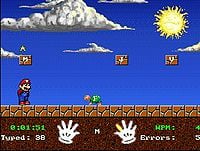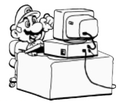Mario Teaches Typing 2
Template:More images Template:Infobox
Mario Teaches Typing 2 is the sequel to Mario Teaches Typing. It was released on October 31, 1996[1]. This sequel includes several new features, including a certificate of achievement, a keyboard that is color-coded for easy reference, an on-screen keyboard, specially customizable lesson plans, and new levels. Additionally, Mario's head also makes small talk with the player throughout the levels. Many of Mario's face's antics in this game are cultural references. This is also the last educational Mario game to be released.
Compatibility
The Windows version of the game can be installed and will work on Windows 3.1, Windows NT 3.1/3.5/3.51, Windows 95, Windows NT 4.0, Windows 98/Me, Windows 2000, and Windows XP/Server 2003 (32-bit versions only; the 64-bit versions for both Intel Itanium- and X86-64 (AMD64)-based systems do not work as they lack both the NTVDM and the WOW subsystem to play it1). It will not work in 32-bit installations of Windows Vista as it will have problems installing. The program will install correctly in 32-bit installations of Windows 7 even without graphics card drivers.
The Mac OS version will work on System 7 all the way up to Mac OS 9. Compatibility is not guaranteed under the Classic environment of PowerPC versions of Mac OS X up until Mac OS X Tiger, as Mac OS X Leopard removed the Classic environment for PowerPC based systems. It will not run on Intel-based Macs or future Apple Silicon Macs due to their inability to run Mac OS 9 and below which is required to run pre-Carbon applications on Mac OS X/macOS as Rosetta (used in Intel versions of Mac OS X Tiger up until Mac OS X Snow Leopard which runs exclusively on X86) only supports PowerPC Mac OS X applications and Rosetta 2 (used in the upcoming macOS Big Sur) will only run X86 Mac apps. Modern Mac users however can use programs like SheepShaver or Basalisk II which emulate older Macs that use Motorola 68000 or PowerPC-based Macs. Users of Intel-based Macs produced between 2006-2011 can also install Windows XP or a 32-bit version of Windows 7 using Bootcamp and run the Windows version of the game.
1 - In the case of Windows XP, only the Professional edition has a 64-bit version as all of the other editions such as Home Edition, Tablet PC Edition, Media Center Edition, etc. are 32-bit only for X86 based systems. There are two versions of Windows XP for Itanium-based systems: Version 2002 (based on the same Windows NT 5.1 codebase as the regular XP for IA-32 (32-bit X86) based systems) and Version 2003 (built on the Windows NT 5.2 codebase used in Windows Server 2003). Windows XP Professional X64 Edition for AMD64 (x86-64) based systems is also built from the NT 5.2 (Server 2003) codebase, but with Service Pack 1 already incorporated. This limitation (of not being able to run 16-bit Windows applications on 64-bit Windows) is also carried over to versions past XP/Server 2003 such as Windows Vista, Windows 7, Windows 8/8.1, and Windows 10 (for both AMD64 and ARM64 based systems). Workarounds, however, do exist to get 16-bit Windows applications running on 64-bit Windows versions.
Story
Mario and Luigi were walking by Bowser's Castle one day when a mysterious typewriter appeared in front of them suddenly. To their amazement, the typewriter starts typing by itself. When it is finished, Mario takes the paper out of the typewriter and right before his eyes, it transforms into a scroll. The scroll reads:
"The Magical Typewriter is the key to beating Bowser. You must type the magic words onto the scroll to cast the spell which will destroy Bowser's Castle.
"Be forewarned, however, that if the magic words are not typed exactly, the Magical Typewriter will self-destruct into pieces."
The Magical Typewriter then floats in front of Mario. Taking the warning to heart, Mario pockets the scroll and begins typing. However, he proves to be a terrible typist:
- Koooppa tTrupa pparraTroopaa Bbow
Before Mario can go on any further, the Magical Typewriter explodes into three pieces, which land in different places. One piece fell into the river, another fell somewhere on Mario and Luigi's side of the river, and the last one fell on the other side of the river. Mario and Luigi decide to recover all of the pieces and improve Mario's typing skills in order to type the spell correctly and ensure their victory.
As Mario and Luigi get the first piece from a dim Koopa Troopa, a Red Koopa Troopa detonates the river bridge with TNT and takes one of the pieces back to Bowser's Castle. Mario then dons a snorkel and dives into the river attempting to get the piece that fell into the river. Luigi goes in also after defeating some Cheep Cheeps that are attacking Mario.
Mario and Luigi, in their snorkels, dive to a sunken ship in the river, taking the typewriter piece from a snoozing octopus. However, the octopus awakens and chases the brothers, though they escape through the ship's windows.
Mario and Luigi then walk up to Bowser's Castle and knock on the door. They are surprised when the castle turns out to be alive, and swallows them. Mario and Luigi run into several traps until finally defeating some Koopas playing poker for the final typewriter piece. The Bros. then escape from the castle, and Mario types on the restored typewriter:
- Koopa Troopa paratroopa Bowser's Castle go kablooka!
A giant typewriter suddenly falls from the sky and destroys Bowser's Castle. Mario and Luigi celebrate.
Levels
- Mario's Smash and Dash - for beginners.
- Mario's Wet World Challenge - for the intermediate typers.
- Mario's Tunnel of Doom - for the advanced players.
- Mario's Expert Express - the hardest level.
Media
Gallery
Mario, Luigi and the Princess with a key
Staff
- Main article: List of Mario Teaches Typing 2 staff
Trivia
- Mario's "I'm a videogame!" routine involves bouncing across the screen and making simplistic noises when hitting the sides, imitating Pong, an early arcade game.
References
- ^ FAQs.org: Mario teaches typing 2 (teacher)-DOS "Date of Recordation: October 31, 1996" (Retrieved March 12, 2011)




